IASbaba's Daily Current Affairs Analysis
Archives
(PRELIMS & MAINS Focus)
Syllabus
- Prelims – Environment and Ecology
Context: For the first time, photos of melanistic Asian golden cat were captured through camera traps in West Bengal’s Buxa Tiger Reserve (BTR). In India, the melanistic morph has been earlier reported from north-eastern states including Sikkim, Assam and Arunachal Pradesh.
About Asiatic Golden Cat:

- The Asian golden cat (Catopuma temminckii ) is a medium-sized wild cat native to the Northeastern Indian subcontinent, Southeast Asia and China.
- The Asian golden cat’s scientific name honours Coenraad Jacob Temminck and is also called Temminck’s cat and Asiatic golden cat.
- Asian golden cats, known as the “fire cat” in Thailand and Burma, and as the “rock cat” in parts of China, are of a medium size and stocky build.
- Asian golden cats are solitary and territorial.
- Once considered nocturnal, a radio-tracking study showed them to be diurnal and crepuscular.
- Asian golden cats are carnivores, often eating small prey like Indochinese ground squirrel, small snakes and other reptiles, muntjacs, rodents, birds, and young hares.
- Asian golden cats are polygynous, which means that one male gets exclusive mating rights with multiple females.
- There appears to be no breeding season for the Asian golden cat, but from April to June no births occur.
- After gestation of about 81 days, 1 to 3 kittens are born.
- Kittens are weaned when they are 6 months old and they reach independence as early as 9 months, the average being 12 months.
- Female Asian golden cats reach sexual maturity between 18 and 24 months, males maturing at 24 months.
- Conservation Status:
- IUCN: Near threatened
- Wildlife Protection Act, 1972: Schedule I
About Buxa Tiger Reserve:
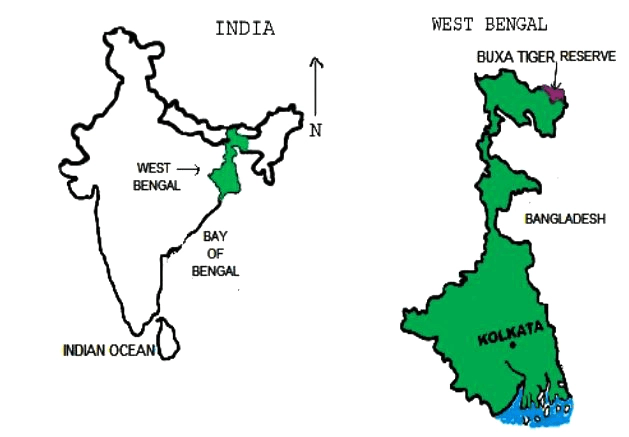
- Buxa Tiger Reserve (BTR) lies in Alipurduar sub-division of Jalpaiguri district of West Bengal.
- Its northern boundary runs along the international border with Bhutan.
- The Sinchula hill range lies all along the northern side of BTR and the Eastern boundary touches that of the Assam State.
- National Highway No.31 C roughly runs along its southern boundary.
- It is the eastern most extension of extreme bio-diverse North-East India and represents highly endemic Indo-Malayan region.
- The fragile “Terai Eco-System” constitutes a part of this Reserve.
- The Phipsu Wildlife Sanctuary of Bhutan is contiguous to North of BTR.
- Manas National Park lies on east of BTR.
- BTR, thus, serves as international corridor for elephant migration between India and Bhutan.
- Some of the endangered species found in BTR are Indian Tiger, Asian Elephant, Leopard cat, Bengal florican, Regal python, Chinese Pangolin, Hispid hare, Hog deer etc.
Source: Hindustan Times
Previous Year Questions
Q.1) With reference to Indian laws about wildlife protection, consider the following statements :
- Wild animals are the sole property of the government.
- When a wild animal is declared protected, such animal is entitled for equal protection whether it is found in protected areas or outside.
- Apprehension of a protected wild animal becoming a danger to human life is sufficient ground for its capture or killing.
Which of the statements given above is/are correct? (2022)
- 1 and 2
- 2 only
- 1 and 3
- 3 only
Q.2) Consider the following animals
- Hedgehog
- Marmot
- Pangolin
To reduce the chance of being captured by predators, which of the above organisms rolls up/roll up and protects/protect its/their vulnerable parts? (2021)
- 1 and 2
- 2 only
- 3 only
- 1 and 3
Syllabus
- Prelims – Governance
Context: Recently, the Food Safety and Standards Authority of India (FSSAI) notified FSSAI (Finance) Regulations, 2023.
About Food Safety and Standards Authority of India (FSSAI):
- It has been established under Food Safety and Standards , 2006 which consolidates various acts and orders that have hitherto handled food related issues in various Ministries and Departments.
- FSSAI has been created for laying down science based standards for articles of food and to regulate their manufacture, storage, distribution, sale and import to ensure availability of safe and wholesome food for human consumption.
- Ministry of Health and Family Welfare, Government of India is the Administrative Ministry for the implementation of FSSAI.
- The Chairperson and Chief Executive Officer of Food Safety and Standards Authority of India (FSSAI) are appointed by Government of India.
- The Chairperson is in the rank of Secretary to Government of India.
- Headquarters: Delhi
About FSSAI (Finance) Regulations, 2023:
- Food Safety and Standards Authority of India Fund was established and will be audited by the Comptroller and Auditor General annually.
- The FSSAI shall maintain this Fund.
- Financial receipts will include grants made to the FSSAI by the Central government and sums realized by way of fees, penalties, and statutory charges.
- It establishes a Finance Committee.
- Composition of Financial Committee include:
- Chairman: Executive Director-Finance of FSSAI
- 2 members: nominated by the FSSAI
- A representative from the Ministry of Health and Family Welfare
- Established the Chief Financial Authority:
- He/she is the CEO of FSSAI.
- He will develop financial report formats and present it to the Finance Committee.
- It will outline the Authority’s financial and cash position, and adherence to the budget.
- The accounts of the Authority shall be audited by the Comptroller and Auditor-General of India or any other person appointed by them on their behalf annually.
Source: The Hindu
Previous Year Questions
Q.1) With reference to foreign-owned e-commerce firms operating in India, which of the following statements is/are correct? (2022)
- They can sell their own goods in addition to offering their platforms as market-places.
- The degree to which they can own big sellers on their platforms is limited.
Select the correct answer using the code given below:
- 1 only
- 2 only
- Both 1 and 2
- Neither 1 nor 2
Q.2) With reference to the ‘Banks Board Bureau (BBB)’, which of the following statements are correct? (2021)
- The Governor of RBI is the Chairman of BBB.
- BBB recommends for the selection of heads for Public Sector Banks.
- BBB helps the Public Sector Banks in developing strategies and capital raising plans.
Select the correct answer using the code given below:
- 1 and 2 only
- 2 and 3 only
- 1 and 3 only
- 1, 2 and 3
Syllabus
- Prelims – Environment and Ecology
The Noble’s Helen, recorded from the Namdapha National Park, is disappearing from its previously known ranges in Myanmar, China, Thailand, Laos, Cambodia and Vietnam.
About Noble’s Helen Butterfly:
- The Noble’s Helen, closest to Papilio antonio from the Philippines and characterised by a large dorsal white spot, was once common in the montane forest at moderate elevations in northern Thailand.
- This species of swallowtail butterfly has also been reported from the Myanmar, Yunnan and Hubei regions of China, Laos, Cambodia and Vietnam.
- Butterflies are considered vital indicators of the state of biodiversity and key ecosystem functions.
- Noble’s Helen with a wingspan of 100-120 mm was initially thought to be an aberration of Papilio Helenus, though the former has an extra white spot in the dorsum of the forewing.
Source: The Hindu
Previous Year Questions
Q.1) Which of the following is not a bird? (2022)
- The Governor of RBI is the Chairman of BBB.
- BBB recommends for the selection of heads for Public Sector Banks.
- BBB helps the Public Sector Banks in developing strategies and capital raising plans.
Select the correct answer using the code given below:
- Golden Mahseer
- Indian Nightjar
- Spoonbill
- White Ibis
Q.2) Certain species of which one of the following organisms are well known as cultivators of fungi? (2022)
- Ant
- Cockroach
- Crab
- Spider
Syllabus
- Prelims – Science and Technology
Context: Recently Health Minister virtually inaugurates National Summit on Quality of Biologicals. NIB is playing a vital role in ensuring that only quality biological products reach the health system, thereby strengthening our Hon’ble Prime Minister’s mission of ensuring quality health and wellness for all.
About National Institute of Biologicals:
- It was set up in 1992 as apex autonomous institute under the administrative control of Ministry of Health and Family Welfare.
- It is performing primary statutory function of Quality Control of Biologicals. e.g., Insulin, erythropoietin, blood products, diagnostic kits.
About Biological:
- Biological therapeutics, also referred to as Biologicals, are those class of medicines which are grown and then purified from large-scale cell cultures of bacteria or yeast, or plant or animal cells.
- Biologicals are a diverse group of medicines which includes vaccines, growth factors, immune modulators, monoclonal antibodies, as well as products derived from human blood and plasma.
- What distinguishes biologicals from other medicines is that these are generally proteins purified from living culture systems or from blood, whereas other medicines are considered as ‘small molecules’ and are either made synthetically or purified from plants.
- Key difference between biologicals and other medicines: biologicals are generally proteins purified from living culture systems or from blood.
- Other medicines are considered as ‘small molecules’ and are either made synthetically or purified from plants.
Source: PIB
Previous Year Questions
Q.1) Consider the following statements:
- Biofilms can form on medical implants within human tissues.
- Biofilms can form on food and food processing surfaces.
- Biofilms can exhibit antibiotic resistance.
Which of the statements given above are correct? (2022)
- 1 and 2 only
- 2 and 3 only
- 1 and 3 only
- 1, 2 and 3
Q.2) Consider the following statements in respect of probiotics :
- Probiotics are made of both bacteria and yeast.
- The organisms in probiotics are found in foods we ingest but they do not naturally occur in our gut.
- Probiotics help in the digestion of milk sugars.
Which of the statements given above is/are correct? (2022)
- 1 only
- 2 only
- 1 and 3
- 2 and 3
Syllabus
- Prelims – Science and technology
In News: Bird flu, a virus not known to spread easily among mammals, led to the culling of 50,000 minks in Spain.
- The findings indicated at least one mutation in the virus’ genome, which may make mammal-to-mammal infection easier.
- It is possible the minks were infected via seabirds in Galicia, a region in Spain, carrying the H5N1 virus since they were kept in an open cage and possibly interacted with the wild birds
Bird flu

- Avian influenza or bird flu refers to the disease caused by infection with avian (bird) influenza (flu) Type A viruses H5N1.
- These viruses naturally spread among wild aquatic birds worldwide and can infect domestic poultry and other bird and animal species.
- Bird flu viruses do not normally infect humans. However, sporadic human infections with bird flu viruses have occurred.
- Typically, mammals catch the avian influenza directly from infected birds, through the consumption of bird droppings or preying on infected animals.
- However, within-mammal transmission was uncharacteristic of the virus until now.
- Poultry birds across Europe, Asia, Africa and North America have been victim to the highly infectious strain of the avian influenza virus.
- The virus H5N1 is evolving and may be gaining pandemic potential as its mutation is the same mutation that was recorded in the gene of the 2009 pandemic swine-origin influenza A (H1N1) virus.
Source: DTE
Previous Year Questions
Q.1) Consider the following statements: (2017)
- In tropical regions, Zika virus disease is transmitted by ‘the same mosquito that transmits dengue.
- Sexual transmission of Zika virus disease is possible
Which of the statements given above is/are correct?
- 1 only
- 2 only
- Both 1 and 2
- Neither 1 nor 2
Q.2) H1N1 virus is sometimes mentioned in the news with reference to which one of the following diseases? (2015)
- AIDS
- Bird flu
- Dengue
- Swine flu
Syllabus
- Prelims: Art and Culture
Ellora Caves
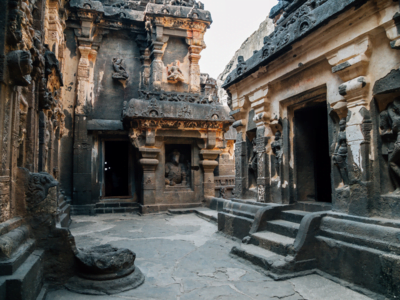
- Situated in Aurangabad district, the Ellora Caves are just awe-inspiring.
- The complex features 34 caves, of which 17 are Hindu caves, 12 are Buddhist caves, and 5 are Jain caves.
- This is also the place where the renowned Kailasa Temple exists, and is full of intricate rock carvings.
- The primary attraction of Ellora is Kailash Temple (cave16) is the most remarkable, and is one of the main attractions that lure visitors to Ellora Caves.
- The caves were granted UNESCO World Heritage Site status in 1983
Elephanta Caves
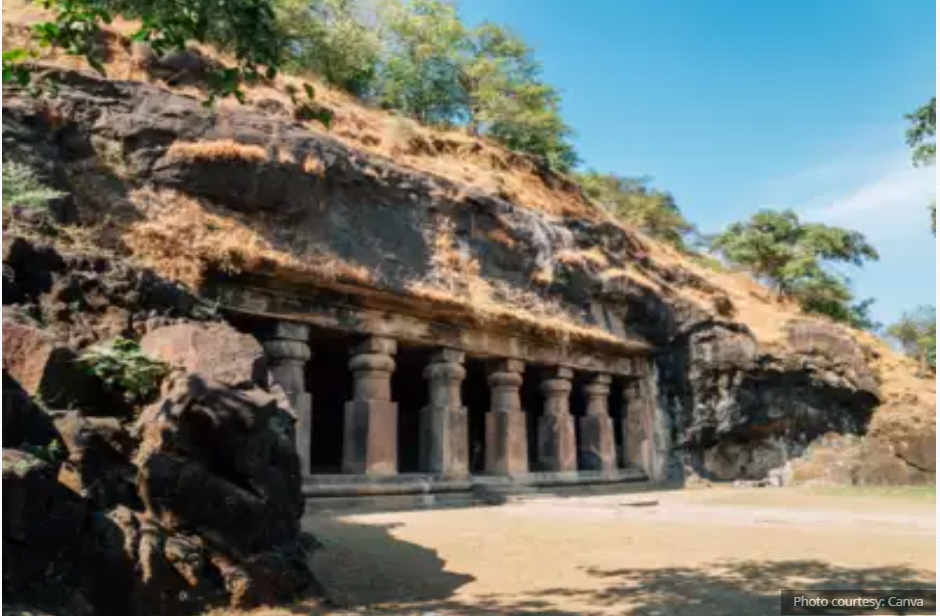
- This is another UNESCO World Heritage Site in Maharashtra, which is a must-visit and highlights the peace and ideology reflected by Buddhism.
- These caves are a network of sculpted caves, and is the oldest historic site
- The Portuguese colonists first discovered the caves and named them Elephanta Caves after spotting elephant statues on the caves.
- There are a total of seven caves that date back between the 5th and 8th centuries, and were listed as heritage sites in 1987.
Ajanta Caves
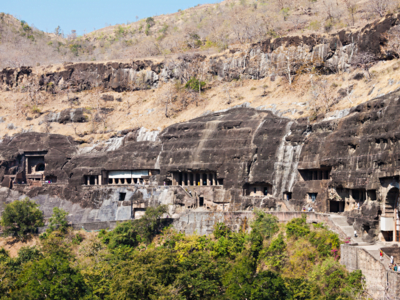
- It comprises a group of 30 rock-cut caves, and are also known for their murals.
- Home to famous Buddhist religious art, this site serves as a great example of ancient Indian art.
- There are a total of 29 caves here, which are all divided into periods, denoting the time when they were built.
- If reports are to go by, they were carved between the 2nd century BCE through CE 650, and feature various stories from the Jataka tales.
- It was declared a World Heritage Site in 1983.
Chhatrapati Shivaji Terminus

- Earlier, it was known as the Victoria Terminus, and was completed in 1888.
- Its construction started in 1878 while its Victorian Gothic Revival architecture stands out amid the hustle bustle of Mumbai.
- Spread across a 2.85 hectare area, this place remains extremely busy almost all the time.
- It’s a historic railway station, which was added to the list of UNESCO World Heritage Sites in 2004.
- This 133-year-old heritage building is not only one of the biggest, but also one of the busiest railway stations in India.
Victorian Gothic & Art Deco Ensembles of Mumbai
- The Victorian Gothic and Art Deco Ensembles of Bombay will offer you a collection of 19th century Victorian neo-Gothic public buildings and 20th century art deco buildings in the Fort area of Mumbai.
- The large edifices serve as relics from a different time, which are so spectacular that they will leave you awed.
- You can find these buildings around the Oval Maidan.
Sources: TOI
Previous Year Question
Q.1) Which one of the following statements is correct? (2021)
- Ajanta Caves lie in the gorge of Waghora river.
- Sanchi Stupa lies in the gorge of Chambal river.
- Pandu-lena Cave shrines lie in the gorge of Narmada river.
- Amaravati Stupa lies in the gorge of Godavari river.
Syllabus
- Prelims: Polity
In News: Even as the Supreme Court has called for reforming death penalty sentencing, trial courts awarded 165 death sentences in 2022, the highest in over two decades, according to the Annual Death Penalty Report, 2022. The report will be released on Monday by Project 39A
- This shift has been sharply influenced by the extraordinary sentencing of 38 persons to death in Ahmedabad in a single bomb blast case, representing the largest number of persons sentenced to death in a single case since 2016
Project 39A
- It is a criminal reforms advocacy group with the National Law University, Delhi.
- It is inspired by Article 39-A of the Indian Constitution, a provision that furthers the intertwined values of equal justice and equal opportunity by removing economic and social barriers
- Project 39A aims to trigger new conversations on legal aid, torture, forensics, mental health in prisons, and the death penalty, using empirical research to re-examine practices and policies in the criminal justice system
- The dismal state and sometimes the absence of record-keeping in the police, prisons and courts along with multiple barriers to accessing records/ data complicates criminal justice research in India.
Source: Indian Express
Syllabus
- Prelims: Polity
In News: A CJI Chandrachud-led bench of the Supreme Court decided to examine a petition challenging the constitutional validity of Section 376 DB of the Indian Penal Code.
- This section describes the punishment for gangrape of a minor under 12 years of age, to the extent that it prescribes a ‘minimum mandatory sentence’ of life imprisonment for the remainder of the convict’s life and even death.
Mandatory minimum sentencing:
- The concept of mandatory minimum sentencing refers to “a sentence which must be imposed without leaving any discretion to the court”.
- It means a quantum of punishment which cannot be reduced below the period fixed – the Apex court held in its 2016 ruling in ‘Mohd Hashim vs State Of UP And Others’.
- Essentially, this predetermines the minimum punishment or sentence for certain offenses which are considered to be more serious than others, with a view to ensure justice and not let the perpetrator of such an offense go unpunished.
- No matter what the unique, individual circumstances of the offender or the offense might be, the court must mandatorily award this minimum period of sentencing for the offenses which prescribe it.
What provisions award a mandatory sentence
- A concept that comes primarily from the Canadian and American legal systems; in India, such sentences are prescribed for all sexual offenses under the Prevention of Children from Sexual Offences (POCSO) Act except the offense of sexual harassment
- Under Section 8 of the POCSO Act, a punishment of 3-5 years has been prescribed for offenses under Section 7 which deals with offenses of sexual assault against children. However, imposing the minimum punishment in such cases is mandatory.
- When the legislature has prescribed a minimum sentence without discretion, the same cannot be reduced by the courts.
- In such cases, imposition of minimum sentence, be it imprisonment or fine, is mandatory and leaves no discretion to the court,” the Supreme Court reiterated in its 2019 ruling in ‘State Of Madhya Pradesh vs Vikram Das’.
- However, it was first in the year 1983, following nationwide protests in the wake of the Supreme Court’s 1978 ruling acquitting two policemen for the rape of a 16-year-old Adivasi girl in ‘Tukaram And Ors v. State Of Maharashtra’ that the Criminal Law Amendment Act Of 1983 was passed.
- The 1983 amendment was the first instance of ‘mandatory minimum punishment’ being prescribed, with seven years for general rapes and ten years for aggravated cases which could include rapes of minors below 12 years, and pregnant women, while the maximum punishment or life imprisonment for both was stipulated as 14 years.
- Years later, in 2012, following the brutal gangrape and death of a medical student in Delhi, the demand for more stringent rape laws with stricter punishments gained widespread momentum.
- This resulted in the Criminal Law (Amendment) Act, of 2013, which expanded the definition of ‘rape’ beyond penetration to include insertion of objects, anal sex, and oral sex.
- The 2013 reforms also updated the definition of ‘life imprisonment’ to mean the entire remainder of the convict’s life and introduced a minimum sentence of 20 years for gang rape. Following this, even the death penalty could be meted out to those repeatedly indulging in such offenses.
What are the arguments for and against?
- The proponents of minimum mandatory sentencing say that it limits the scope for judicial discretion and arbitrariness, thereby enhancing the cause of justice.
- It is also believed that it acts as a deterrent for serious or harsh offenses by ensuring that the perpetrator doesn’t go unpunished.
- On the other hand, critics say that this leads to overcrowding of prisons and is unfair as the convict’s mitigating circumstances, such as if they are a first-time offender or the sole breadwinner in the family, are often overlooked.
- Moreover, such provisions can often have unintended consequences as judges might feel the prescribed punishment to be excessively stringent in such cases and acquit the accused altogether
Source: Indian Express
Syllabus
- Mains: GS 1 (Geography) and GS 2 (Governance)
Context: The government’s decision to issue notice to Pakistan, calling for negotiations to amend the Indus Waters Treaty, must be considered carefully.
About Indus Water Treaty:
- Indus River System is a Himalayan river system and is one of the largest river basins in the world.
- The Indus River, also known as Sindhu river, is a part of one of the most fertile regions of the Indian sub-continent and the world.
- The main tributaries of the Indus River form the Indus River System, which includes Indus, Jhelum, Chenab, Ravi, Beas, and Satluj.
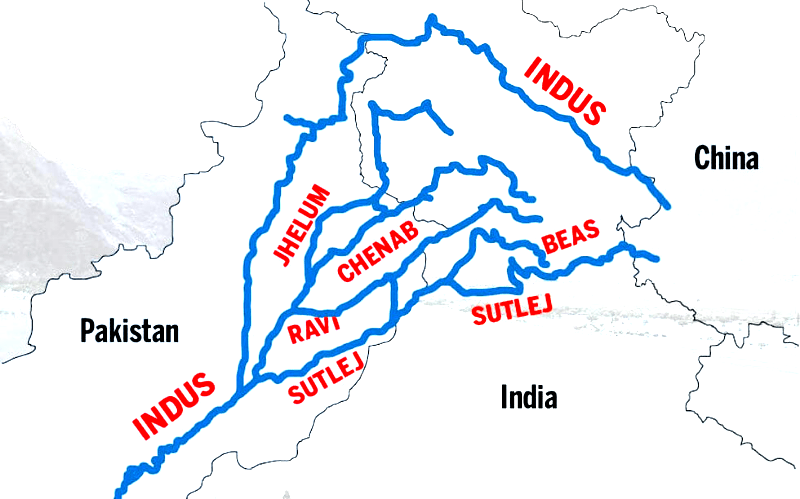
History of the Indus Waters Treaty:
- The Indus river basin has six rivers – Indus, Jhelum, Chenab, Ravi, Beas and Sutlej, originating from Tibet and flowing through the Himalayan ranges to enter Pakistan, ending in the south of Karachi.
- In 1947, the line of partition, aside from delineating geographical boundaries for India and Pakistan, also cut the Indus river system into two.
- Initially, the Inter-dominion accord of May, 1948 was adopted, where both countries, after meeting for a conference, decided that India would supply water to Pakistan in exchange for an annual payment made by the latter.
- This agreement however, soon disintegrated as both the countries could not agree upon its common interpretations.
- In 1951, in the backdrop of the water-sharing dispute, both the countries applied to the World Bank for funding of their respective irrigation projects on Indus and its tributaries, which is when the World Bank offered to mediate the conflict.
- Finally in 1960, the World Bank mediated agreement was reached between the two countries and the Indus Waters Treaty (IWT) was signed by former Prime Minister Jawaharlal Nehru and then President of Pakistan, Ayyub Khan.
Key provisions of the Indus Waters Treaty
Water Sharing Provisions:
- The treaty prescribed how water from the six rivers of the Indus River System would be shared between India and Pakistan.
- The three western rivers—Indus, Chenab and Jhelum—were allotted to Pakistan for unrestricted use.
- The three Eastern rivers—Ravi, Beas and Sutlej—were allocated to India for unrestricted usage.
- Thus by provisions of treaty 80% of the share of water or about 135 Million Acre Feet (MAF) went to Pakistan while India left with the rest 33 MAF or 20% of water for its usage.
Administrative provisions:
- It required both the countries to establish a Permanent Indus Commission constituted by permanent commissioners on both sides.
- The commission will serve as a forum for exchange of information on the rivers, for continued cooperation and as the first stop for the resolution of conflicts.
Operational provisions:
- Although Pakistan has rights over the waters of Jhelum, Chenab and Indus. Annexure C of the treaty allows India certain agricultural uses.
- Annexure D allows India to build ‘run of the river‘ hydropower projects (projects not requiring live storage of water).
- India needs to share information on the project design or alterations made to it with Pakistan who can raise objections or can reserve its concern within 3 months.
- India is allowed to have a minimum storage level on the western rivers – meaning it can store up to 3.75 MAF of water for conservation and flood storage purposes.
Dispute resolution mechanism: The IWT provides a three-step dispute resolution mechanism, under which
- First, “Questions” on both sides can be resolved at the Permanent Commission, or can also be taken up at the inter-government level.
- Disputes/differences unresolved on the first level can be taken to the World Bank who appoints a Neutral Expert (NE) to come to a decision.
- Eventually, if either party is not satisfied with the NE’s decision or in case of “disputes” in the interpretation and extent of the treaty, matters can be referred to a Court of Arbitration.
Annulment provisions:
- The treaty does not provide a unilateral exit provision to either country.
- It is supposed to remain in force unless both the countries ratify another mutually agreed pact.
Criticisms:
- Internationally, the Treaty is seen as one of the most successful cases of conflict resolution but between the two countries, it has seeded dissatisfaction and conflicts regarding its interpretation and implementation.
- The treaty is highly technical leading to far-ranging divergences between the two countries in terms of interpretations.
- For example, the treaty says that storage systems can be built but to a limited extent.
- However, the technical details make it difficult to conclude under what circumstances projects can be carried out.
- Another concern is the tense political relations between the two countries.
From the Indian point of view:
- The basic dissatisfaction is that the treaty prevents it from building any storage systems on the western rivers, even though it allows building storage systems under certain exceptional circumstances.
From Pakistan’s point of view:
- Due to its suspicions, stays aware of every technical aspect of the project and deliberately tries to get it suspended.
- The matter is further aggravated by the fact that the western rivers lie in the disputed region of Jammu and Kashmir, a subject of a tussle between both since independence.
Recent developments:
- Indian government in January 2023 notified Pakistan of its intent to modify the IWT.
- It says this extreme step is due to Pakistan’s intransigence over objections to two Indian hydropower projects in Jammu and Kashmir:
- the 330MW Kishanganga hydroelectric project (Jhelum) and the 850MW Ratle hydroelectric project (Chenab).
- India has argued since 2006, when the objections began, that the projects were within the treaty’s fair water use.
- However, Pakistan has refused to conclude negotiations with India in the bilateral mechanism — the Permanent Indus Commission (PIC) of experts that meets regularly — and has often sought to escalate it.
- As a result, the World Bank appointed a neutral expert, but Pakistan pushed for the case to be heard at The Hague.
- India has objected to this sequencing, as it believes that each step should be fully exhausted before moving on to the next.
- While India was able to prevail over the World Bank to pause the process in 2016, Pakistan persisted, and since March 2022, the World Bank has agreed to have both a neutral expert and a Court of Arbitration (CoA) hear the arguments.
- India attended the hearings with the neutral expert last year, but has decided to boycott the CoA at The Hague that began its hearing recently.
Way Forward:
In the last six decades the Indus Waters Treaty has been one of the most successful water-sharing endeavours in the world today. However, there is a need to update certain technical specifications and expand the scope of the agreement to address climate change.
Therefore there is a need to renegotiate the treaty terms, update certain technical specifications and expand the scope of the agreement to address demands of the two countries amid the rising climate crisis.
Source: The Hindu
Syllabus
- Mains – GS 2 Polity and Social Justice
Context:
- The Justice G. Rohini-led commission for the sub-categorisation of other backward classes (OBCs) has now been given yet another extension in its tenure by the President
- This is the 14th extension in tenure that the commission has been given.
About the commission
- The commission was formed in October 2017
- It was initially given 12 weeks to finish the task of sub-categorising the nearly 3,000 castes within the OBC umbrella and recommend division of the 27% OBC quota among them equitably
- As part of its work, the commission had identified dominant caste groups among all OBC communities in the Central list, finding that a small group of dominant OBC communities were crowding out a large number of communities from the 27% OBC quota.
- Consequently, the commission decided to divide all OBC communities into four broad categories, with the largest share of the quota pie going to the group that has historically been deprived of OBC quota as a result of being pushed out by dominant OBC groups.
Commission’s terms of reference:
- To examine the extent of inequitable distribution of benefits of reservation among the castes or communities included in the broad category of OBCs with reference to such classes included in the Central List.
- To work out the mechanism, criteria, norms and parameters in a scientific approach for sub-categorisation within such OBCs.
- To take up the exercise of identifying the respective castes or communities or sub-castes or synonyms in the Central List of OBCs and classifying them into their respective sub-categories. A fourth term of reference was added on January 22, 2020.
- To study the various entries in the Central List of OBCs and recommend correction of any repetitions, ambiguities, inconsistencies and errors of spelling or transcription.
What is sub-categorisation of OBCs?
- The idea is to create sub-categories within the larger group of OBCs for the purpose of reservation.
- OBCs are granted 27% reservation in jobs and education under the central government, this has been a legal debate for other reservation categories too
- In 2022, a Constitution Bench of the Supreme Court reopened the debate on sub-categorisation of Scheduled Castes and Scheduled Tribes for reservations.
- For OBCs, the debate arises out of the perception that only a few affluent communities among the over 2,600 included in the Central List of OBCs have secured a major part of the 27% reservation.
- The argument for creating sub-categories within OBCs is that it would ensure “equitable distribution” of representation among all OBC communities.
- It was to examine this that the Rohini Commission was constituted on October 2, 2017
Need for subcategorization
- Due to inequalities and further inequalities within unequal entities.
- Reservation in jobs and education did address socio-economic disparities in India to some degree, but, the benefits of reservation have not been distributed equitably
- Large segments of the weaker sections and backward classes continue to have no access to quality education or meaningful employment.
- The relatively rich and dominant sections among the backward castes have tended to take up a disproportionately larger share of the reservation pie.
- Failure in effectively preventing large sections of the creamy layer from taking advantage of the quota system to the detriment of the poorer sections among their own caste groups.
- To ensure a more equitable distribution of reservation benefits by further differentiating caste groups coming under backward classes on the basis of their levels of social and economic backwardness.
- Lacunae in categorisation of the creamy layer led to the need to differentiate among the caste groups.
- Vote-bank politics has caused prioritising of caste-based categorisation over income-based differentiation to identify reservation beneficiaries.
- The reservation pie is limited, and no group, whether rich or poor, dominant or subservient, can hope to gain except at the expense of another socio-economic category.
Findings of the commission
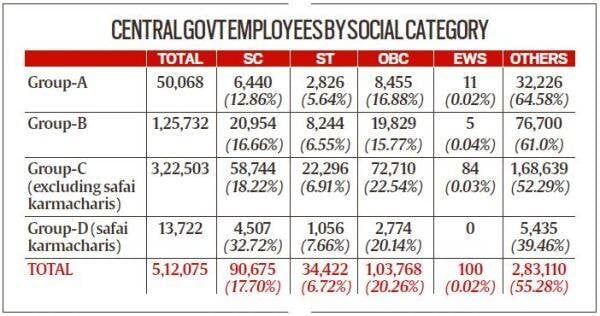
- In 2018, the Commission analysed the data of 1.3 lakh central jobs given under OBC quota over the preceding five years and OBC admissions to central higher education institutions, including universities, IITs, NITs, IIMs and AIIMS, over the preceding three years.
- The findings were: 97% of all jobs and educational seats have gone to just 25% of all sub-castes classified as OBCs; 24.95% of these jobs and seats have gone to just 10 OBC communities; 983 OBC communities — 37% of the total — have zero representation in jobs and educational institutions; 994 OBC sub-castes have a total representation of only 2.68% in recruitment and admissions.
- Total number of Group A to Group C employees (including safai karmacharis) was 5.12 lakh – Of these, 17.70% are SC, 6.72% ST, 20.26% OBC (Other Backward Classes), and 0.02% EWS (Economically Weaker Sections).
- In Group-A, the highest tier among these, the representation of SCs is just 12.86%, of STs 5.64% and of OBCs 16.88%. Reservation for these communities is 15%, 7.5% and 27% respectively.
Challenges
- Disruptions caused by COVID-19 pandemic.
- Different states census underway – Bihar government is in the middle of its caste-based survey in the State and the Uttar Pradesh government is in the process of conducting a fresh survey to assess the need for OBC reservation in its local body elections, with other States like Madhya Pradesh and Maharashtra also looking to form panels to implement OBC reservation in local body polls.
- Government lacks information for data enumeration of OBC
- Data from 2011 Socio-Economic Caste Census were never made public.
- Enumeration of OBC data is administratively complex and the information lacks completeness and accuracy since the State and Central list of OBCs are distinct.
- It may lead to breach of apex court’s 50-per-cent ceiling, since many communities have sought separate reservations at the State and Central levels across India.
Way forward
- According to 2018 data, just ten OBC communities have taken the 25 per cent of reserved central jobs and institutional seats. Also, 97 per cent of the reserved jobs and seats have gone to 25 per cent of OBC sub-castes.
- Hence, there is a need to re-establish equity and the task has been handed over to Rohini Commission
- Once completed, the report by Justice G Rohini commission is also likely to undergo judicial review
Source: The Hindu
Practice MCQs
Q.1) H5N1 virus is sometimes mentioned in the news with reference to which one of the following diseases?
- AIDS
- Bird flu
- Dengue
- Swine flu
Q.2) With reference to mandatory sentences in judicial system, consider the following statements:
- The concept is originally Canadian.
- In India, such sentences are prescribed for all sexual offenses under the Prevention of Children from Sexual Offences (POCSO) Act including the offense of sexual harassment.
Which of the above statements are incorrect?
- Only 1
- Only 2
- Both 1 and 2
- Neither 1 nor 2
Q.3) Consider the following statements regarding National Institute of Biologicals:
- It was set up in 1992 as apex autonomous institute under the administrative control of Ministry of Chemicals and Fertilizers.
- It is performing primary statutory function of Quality Control of Insulin, erythropoietin, blood products, diagnostic kits.
Which of the statements given above is/are correct?
- 1 only
- 2 only
- Both 1 and 2
- Neither 1 nor 2
Comment the answers to the above questions in the comment section below!!
ANSWERS FOR ’ 31st January 2023 – Daily Practice MCQs’ will be updated along with tomorrow’s Daily Current Affairs
ANSWERS FOR 30th January – Daily Practice MCQs
Q.1) – b
Q.2) – b
Q.3) – a














